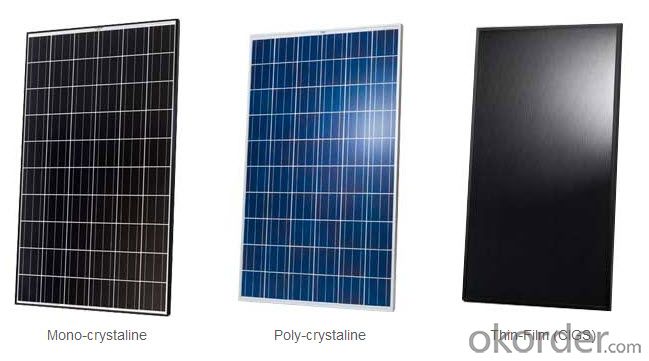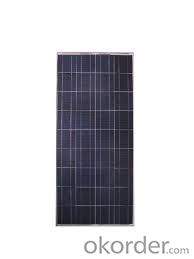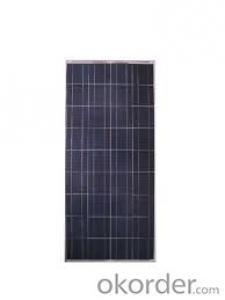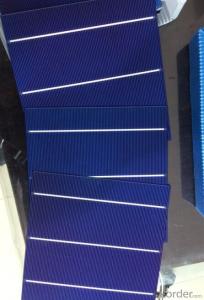235W Poly solar Panel with 25 Years Warranty CNBM
- Loading Port:
- Qingdao
- Payment Terms:
- TT OR LC
- Min Order Qty:
- 10 set
- Supply Capability:
- 300000 set/month
OKorder Service Pledge
OKorder Financial Service
You Might Also Like
Polycrystalline Solar Modules
CNBM offers a range of small, medium and large polycrystalline solar modules, designed for a range of requirements.


Specifications:
Tolerance | +/-3% |
Cell | Polycrystalline silicon solar cells (156 x 156mm) |
N0. of Cells | 60 (10 x 6) |
Dimension of Modules (mm) | 1650 x 990 x 40 |
Weight (kg) | 25.5 |
Limits:
Operating Temperature | -40~+85? |
Storage Temperature | -40~+85? |
Maximum System Voltage | 1000 VDC max. |
Hail Impact | Diameter of 28mm with impact speed |
Temperature and Coefficients:
NOCT | 48C+/-2? |
Voltage temperature coefficient (%/K) | -0.35 |
Current temperature coefficient (%/K) | 0.05 |
Power temperature coefficient (%/K) | -0.45 |
Characteristics:
Model: | SGM-200P | SGM-210P | SGM-220P |
Max-power voltage Vmp (V) | 29.2 | 29.4 | 29.41 |
Max-power current Imp (A) | 6.85 | 7.14 | 7.48 |
Open-circuit voltage Voc (V) | 36.5 | 36.69 | 36.9 |
Short-Circuit Current Isc (A) | 7.28 | 7.6 | 7.93 |
Max-power Pm(W) | 200 | 210 | 220 |
Model: | SGM-230P |
Max-power voltage Vmp (V) | 29.8 |
Max-power current Imp (A) | 7.72 |
Open-circuit voltage Voc (V) | 37.31 |
Short-Circuit Current Isc (A) | 8.19 |
Max-power Pm(W) | 230 |
STC: Irradiance 1000W/m2, module temperature 25?, AM-=1.5
Poly Crystalline Solar Panels Specifications Range
Maximum Power (Pm) | Dimension | Weight | Operating Voltage (Vmp) | Operating Current (Imp) | Open Circuit Voltage (Voc) | Short Circuit Current (Isc) |
0.45W | 140x80x10mm | 0.08kg | 3.3V | 150mA | 4.6V | 160mA |
1.0W | 162x140x10mm | 0.16kg | 7.5V | 150mA | 10.3V | 160mA |
4.5W | 269x251x23mm | 0.8kg | 16.5V | 0.27A | 20.5V | 0.3A |
10W | 420.1×268.9×22.6mm | 1.92kg | 17.5V | 0.58A | 20.5V | 0.6A |
20W | 425x502x50mm | 3.0kg | 16.8V | 1.19A | 21.0V | 1.29A |
30W | 593x502x22.6mm | 3.9kg | 16.8V | 1.78A | 21.0V | 1.94A |
40W | 655x537x50mm | 5.75kg | 17.3V | 2.31A | 22.1V | 2.54A |
50W | 839x537x50mm | 6.0kg | 17.5V | 2.9A | 21.8V | 3.17A |
65W | 1111x502x50mm | 7.2kg | 17.6V | 3.69A | 22.1V | 3.99A |
80W | 1204x537x50mm | 7.7kg | 17.6V | 4.55A | 22.1V | 4.8A |
- Q:Can solar cells be used for powering remote sensing devices?
- Yes, solar cells can be used to power remote sensing devices. Solar cells convert sunlight into electricity, which can then be used to power various electronic devices, including remote sensing devices. This renewable energy source is particularly advantageous for remote sensing applications as it eliminates the need for traditional power sources and allows for greater flexibility and portability in remote locations.
- Q:Why are the poly Solar cell specifications is different from each other, they seem to have the different size of 125mm, 156mm, 152mm, is the 152mm's battery technology is higher than the other?
- We seldom see poly solar cell with the size of 152, because that is not really good to use.
- Q:Can solar cells be used in powering e-bikes?
- Yes, solar cells can be used to power e-bikes. Solar panels can be mounted on the bike's frame or incorporated into accessories like panniers or baskets. These panels convert sunlight into electricity, which charges the bike's battery, providing a renewable and sustainable source of power.
- Q:Can solar panels be charged with light?
- amorphous silicon, gallium arsenide, selenium and other copper. Their power generation principle is basically the same, now crystal silicon as an example to describe the photovoltaic power generation process. P-type crystalline silicon doped with phosphorus can be obtained N-type silicon, the formation of P-N junction.
- Q:Can somebody list some of the materials used for making solar cells?
- There are at least 10 materials you need to prepare.
- Q:How do solar cells affect the electric grid?
- Solar cells can have a significant impact on the electric grid by generating clean and renewable energy. When connected to the grid, solar cells produce electricity during the day, reducing the overall demand for power from traditional sources. This reduces the strain on the grid and decreases the need for fossil fuel-based power plants. Additionally, excess solar energy generated by these cells can be fed back into the grid, providing a source of power for others and contributing to a more resilient and sustainable energy system.
- Q:Can solar cells be used in residential applications?
- Yes, solar cells can be used in residential applications. They are commonly used to generate electricity for homes, providing a clean and renewable energy source. Solar panels are installed on rooftops or in yards, capturing sunlight and converting it into usable electricity for various household needs. This helps reduce reliance on traditional power grids and lowers carbon emissions, making it an environmentally friendly and cost-effective solution for residential energy needs.
- Q:Can solar cells be used to power off-grid cabins or homes?
- Yes, solar cells can be used to power off-grid cabins or homes. Solar panels can generate electricity by converting sunlight into usable energy, which can then be stored in batteries for use during periods of low sunlight or at night. This makes solar power an ideal and sustainable solution for off-grid living, providing a reliable source of electricity without the need for a traditional power grid connection.
- Q:Can solar cells be used for powering navigation buoys?
- Yes, solar cells can be used for powering navigation buoys. Solar cells are a reliable and sustainable source of energy that can be used to power various devices, including navigation buoys. They can harness sunlight and convert it into electricity, providing a continuous power supply for the buoys' operations. This eliminates the need for traditional fuel-based generators or batteries, making solar cells a cost-effective and environmentally-friendly option for powering navigation buoys.
- Q:What is a polycrystalline solar cell?
- A polycrystalline solar cell is a type of solar cell made from multiple crystal structures, resulting in a grainy appearance. It is less expensive to produce compared to monocrystalline cells, but typically has lower efficiency levels.
1. Manufacturer Overview |
|
|---|---|
| Location | |
| Year Established | |
| Annual Output Value | |
| Main Markets | |
| Company Certifications | |
2. Manufacturer Certificates |
|
|---|---|
| a) Certification Name | |
| Range | |
| Reference | |
| Validity Period | |
3. Manufacturer Capability |
|
|---|---|
| a)Trade Capacity | |
| Nearest Port | |
| Export Percentage | |
| No.of Employees in Trade Department | |
| Language Spoken: | |
| b)Factory Information | |
| Factory Size: | |
| No. of Production Lines | |
| Contract Manufacturing | |
| Product Price Range | |
Send your message to us
235W Poly solar Panel with 25 Years Warranty CNBM
- Loading Port:
- Qingdao
- Payment Terms:
- TT OR LC
- Min Order Qty:
- 10 set
- Supply Capability:
- 300000 set/month
OKorder Service Pledge
OKorder Financial Service
Similar products
New products
Hot products
Hot Searches
Related keywords
































